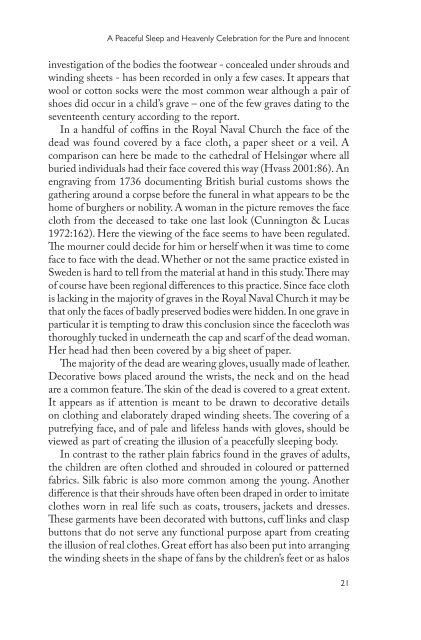Making Sense of Things
Making Sense of Things
Making Sense of Things
You also want an ePaper? Increase the reach of your titles
YUMPU automatically turns print PDFs into web optimized ePapers that Google loves.
A Peaceful Sleep and Heavenly Celebration for the Pure and Innocent<br />
investigation <strong>of</strong> the bodies the footwear - concealed under shrouds and<br />
winding sheets - has been recorded in only a few cases. It appears that<br />
wool or cotton socks were the most common wear although a pair <strong>of</strong><br />
shoes did occur in a child’s grave – one <strong>of</strong> the few graves dating to the<br />
seventeenth century according to the report.<br />
In a handful <strong>of</strong> c<strong>of</strong>fins in the Royal Naval Church the face <strong>of</strong> the<br />
dead was found covered by a face cloth, a paper sheet or a veil. A<br />
comparison can here be made to the cathedral <strong>of</strong> Helsingør where all<br />
buried individuals had their face covered this way (Hvass 2001:86). An<br />
engraving from 1736 documenting British burial customs shows the<br />
gathering around a corpse before the funeral in what appears to be the<br />
home <strong>of</strong> burghers or nobility. A woman in the picture removes the face<br />
cloth from the deceased to take one last look (Cunnington & Lucas<br />
1972:162). Here the viewing <strong>of</strong> the face seems to have been regulated.<br />
The mourner could decide for him or herself when it was time to come<br />
face to face with the dead. Whether or not the same practice existed in<br />
Sweden is hard to tell from the material at hand in this study. There may<br />
<strong>of</strong> course have been regional differences to this practice. Since face cloth<br />
is lacking in the majority <strong>of</strong> graves in the Royal Naval Church it may be<br />
that only the faces <strong>of</strong> badly preserved bodies were hidden. In one grave in<br />
particular it is tempting to draw this conclusion since the facecloth was<br />
thoroughly tucked in underneath the cap and scarf <strong>of</strong> the dead woman.<br />
Her head had then been covered by a big sheet <strong>of</strong> paper.<br />
The majority <strong>of</strong> the dead are wearing gloves, usually made <strong>of</strong> leather.<br />
Decorative bows placed around the wrists, the neck and on the head<br />
are a common feature. The skin <strong>of</strong> the dead is covered to a great extent.<br />
It appears as if attention is meant to be drawn to decorative details<br />
on clothing and elaborately draped winding sheets. The covering <strong>of</strong> a<br />
putrefying face, and <strong>of</strong> pale and lifeless hands with gloves, should be<br />
viewed as part <strong>of</strong> creating the illusion <strong>of</strong> a peacefully sleeping body.<br />
In contrast to the rather plain fabrics found in the graves <strong>of</strong> adults,<br />
the children are <strong>of</strong>ten clothed and shrouded in coloured or patterned<br />
fabrics. Silk fabric is also more common among the young. Another<br />
difference is that their shrouds have <strong>of</strong>ten been draped in order to imitate<br />
clothes worn in real life such as coats, trousers, jackets and dresses.<br />
These garments have been decorated with buttons, cuff links and clasp<br />
buttons that do not serve any functional purpose apart from creating<br />
the illusion <strong>of</strong> real clothes. Great effort has also been put into arranging<br />
the winding sheets in the shape <strong>of</strong> fans by the children’s feet or as halos<br />
21

















